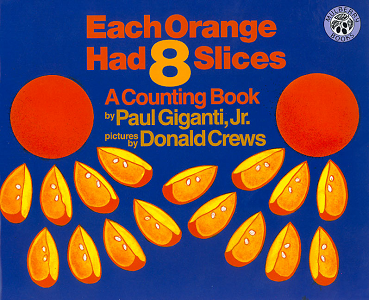Reading Each Orange Had 8 Slices
- Matt Felton-Koestler
- Aug 28, 2017
- 5 min read

Last night Courtney and Parker were reading Each Orange Had 8 Slices by Paul Giganti, Jr. and illustrated by Donald Crews. They didn't finish, so Parker wanted to read it with me tonight. Each page of the book follows a pretty similar format (see the image below):
There are __ groups.
Each group has ___ subgroups.
Each subgroup has ___ items.
After that there are a series of three questions, which also follow a similar format:
How many groups are there?
How many subgroups are there?
How many items were there in all?

Posing Problems
If I were using this book with children I would consider covering up the questions on each page and asking the children what questions they could ask. I've done this before with Parker and he has sometimes come up with questions I wouldn't have thought of. It's easy, as an adult, to get stuck in the obvious rut of these three questions. Also, providing children with opportunities to pose their own (math) problems or questions about the world is extremely important. It's an early component to something called mathematical modeling. Modeling is the process of identifying a real world problem or phenomenon to solve or investigate, learning about the situation, figuring out how mathematics can be used to solve/investigate the situation, doing the math, and then interpreting the results and seeing if they solve the problem in the real world or provide a deeper understanding of the situation. This is how engineers, scientists, data analysts, etc. use math in the real world and it's often absent from the math classroom.
Today, however, Parker wanted me to just read the questions.
It Can Be Had to Know What Kids Know
Parker seems to have shifted gears mathematically and wants to do everything in his head. He's also not particularly patient. This often leads to him trying to guess answers quickly instead of working through the problem, either mentally or by using pictures, blocks, or fingers (which is not uncommon for kids who are starting to get comfortable with using math facts). On this page he figured out how many spotted eggs there are mentally. He knew 6 and 6 was 12 and that 12 and 12 was 24. I believe he knows 6 and 6 is 12. For the 12 and 12 it's not clear to me if (a) he quickly did 10 and 10 and then 2 and 2 (which he has done before), (b) remembered it from having done it before, or (c) got lucky with a guess. I asked if he did (a) and he said no, that he just kind of knew it... but I heard him whispering some things under his breath when figuring it out, so I'm not sure.
This points to one of the real challenges of teaching. It can be really hard to uncover children's thinking. It can be hard to monitor your own thinking when your in the middle of doing something challenging. If a child is right at the outer edge of what they are capable of doing, they're not always able to track all of their own thinking, much less explain it back to you. This is due, in part, to the fact that their thinking is likely evolving as they solve the problem. Their knowledge is in flux, right then and there.
It's clear from the research (done with real kids and teachers in real classrooms) that pushing students for explanations is valuable for several reasons: (1) being able to explain and justify your thinking is an important skill in and of itself and kids won't learn it if they don't do it, (2) it strengthens student understanding (for both the explainer and the listeners), and (3) it helps the teacher understand the students thinking which can inform their future instruction.
However, as I just pointed out, it can be really hard to know what kids know. So teachers constantly have to judge how much explanation to push for—when is it productive and when does it start to become confusing? When can something just be "taken for granted" (for instance, I don't stop and ask Parker why 2 and 2 is 4 every time)? How do you decide what can be "taken for granted" for the whole class vs. individual students? There are a million decisions teachers have to make in navigating these conversations. That's one reason I (and many others) think child-centered mathematics is so engaging as a teacher. However, it can also make it scary for teachers and future teachers who aren't used to it. While there are principles to be followed (like making sure the kids are doing the math, not the teacher or the book), there's not a script you can follow or read from the textbook.
Checking With Another Strategy
Back to Parker's mental math. I was pleased that Parker chose to check his strategy by counting the actual eggs on the page, and I told him it's good to use more than one strategy to check your thinking. It can help you feel more sure about your answer. In particular, I think it's important for Parker to use tools (like the pictures on the page) in addition to mental strategies, especially considering where he is developmentally.
Math and the Real World
One thing that really excited me was that Parker said the bird nests couldn't be like this in real life. I was thinking, "yeah, it's not going to be perfectly arranged in four trees like that." But what I said was "why do you think that?" (a variant on what do you think?). Parker said he thinks the nests need to be more spread out or else the birds would get in fights and asked me if I thought that was true. I said I didn't know, but that a lot of animals do need a certain amount of space. I'm sure we'll look the answer up at some point in the future.
So I told Parker that he was doing something really important, and I was super excited because this is one of the things I research. He was thinking about how the math is related to the real world. We looked through several pages of the book and talked about how in real life it probably wouldn't work out so perfectly. I said these are stories. They are things you can imagine. But scientists who use math have to think about how it works in the real world (in other words, they do mathematical modeling). I told Parker he'd see a lot of these kinds of stories in math class.
Then Parker told me he was tired of talking about this, so we read another book and went to bed.
Share Your Thoughts (post a comment!)
What questions would you ask about the picture above? What are some of your favorite children's books and how does or could math show up in them? What's your strategy for figuring out how many eggs there are?


Comments